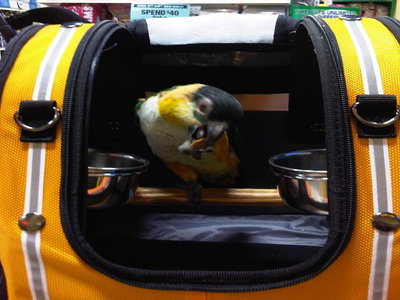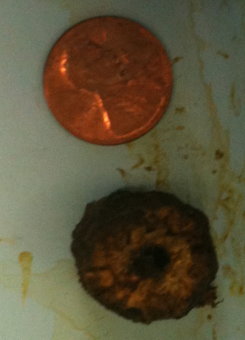
Travelling with Parrots is relatively simple – but your & your family need to plan things well in advance.
Desensitization – this situation is simplified if you are going to drive with them in my experience. Typically, parrots travel very, very well-as long as you prepare them and, then yourself. Begin to desensitize them to their traveling “crate” as soon as you can.
Carrier choice – You need to place one or two perches across an appropriately sized plastic cat carrier. A simple “dowel” likely won’t do for proper grip so, finding Dragonwood or other perches through online bird stores that have more of a grip-texture that would be better for your birds. You’ll also need to place a towel in the bottom of the carrier and have extras with you on the road to change out daily. You can also purchase (online) appropriately sized stainless steel water and food bowls that will attach to the doorway of the kennel. I strongly recommend you do not use plastic bowls with birds like this-while you will think they may not destroy them-the moment you leave them unattended in the carrier and look elsewhere/take your eyes off of them- they usually will.
http://www.celltei.com/ also is an excellent company who makes carriers that are soft sided, easily secured, very easy to clean, mobile & light to carry. They already have perches in them with appropriate water bowls that come with them as well. However, they are little more expensive-if you do decide to purchase one of these for your bird – Ensure you get the stainless steel mesh and not the plastic mesh! While the latter is cheaper, for the same reasons noted above-stainless steel is better-the birds really have to try hard to get out of them. My Caique made easy work of chewing the plastic mesh once during a 20 minute commute to my practice with her – this was well after she was used to the carrier! Finally, Celltei carriers are also very convenient for travel-I move my birds exclusively in these carriers. Also- the company is very good about the occasional repair from one of my more robust parrots.
If you are traveling the winter or colder months – Celltie also makes fleece covers for the carriers that are absolutely perfect. If you don’t have towels over the carriers or have the ability to towel them-you will need to consider this depending on the length of time your on the road and in keeping with the birds 12 hour light cycle.
Tolerizing your bird to the carrier & travelling – Once you “desensitize” your bird by placing them in the carrier and rewarding them for perching, do some interactive enrichment as well and possibly even some foraging exercises which are “self-rewarding” activity for them to actually play in the carrier and get used to being in an enclosed space. And you increase the time in the carrier over days and weeks until your hundred percent comfortable that they are 100% comfortable in them or as best as they can be. Consider taking your bird on short day-trips for progressively longer times.
You’ll also need to bring bottled water with you and try not to change the brand while you’re traveling. You will also likely need to bring some form of suction cup perch also available online from various distributors so that you can have them perch at points in the hotel room or, more appropriately in the bathroom tub and if needed, you can shower them.
Ensure that you also bring their favorite food and treats but, you must be certain that every night they eat and drink well and try to keep them on their light cycle as much as possible. Of course you can leave some water and food in the carriers while you’re traveling.
Jeff Goodall, DVM
Owner/Medical Director
Sunnyview Animal Care
36 Duke Street, Unit #6
Bedford, Nova Scotia
B4A 2Z5
www.sunnyview.vet



